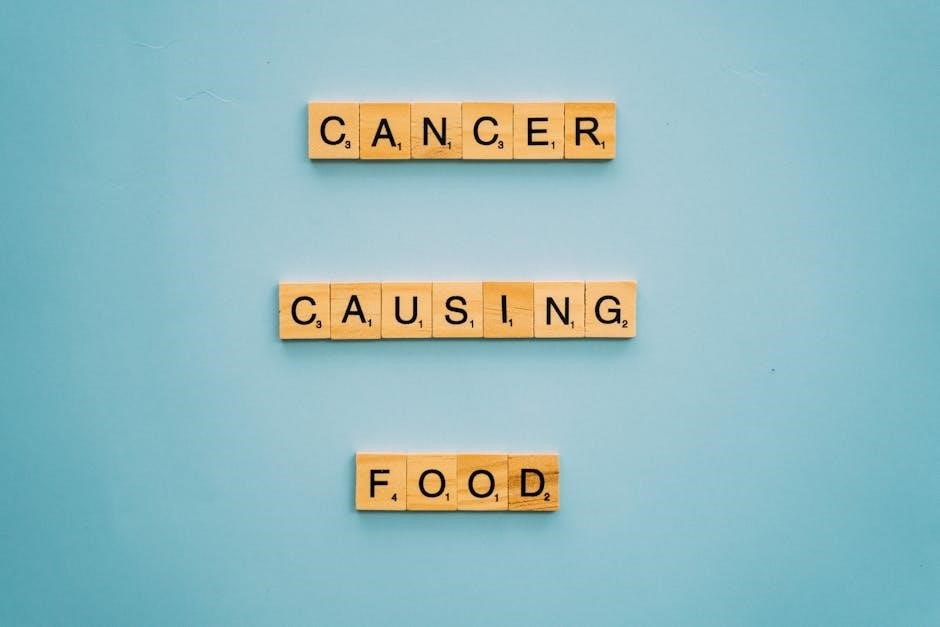Celiac disease is an autoimmune disorder triggered by gluten, causing intestinal damage and malabsorption․ A strict gluten-free diet is essential to manage symptoms and promote healing․
1․1 Definition and Overview of Celiac Disease
Celiac disease is a chronic autoimmune disorder primarily affecting the small intestine, triggered by the consumption of gluten, a protein found in wheat, barley, and rye․ It causes immune-mediated damage to the intestinal villi, leading to malabsorption of essential nutrients․ This condition is distinct from gluten intolerance or sensitivity, as it involves a specific immune response․ Celiac disease is genetic and can manifest at any age, often with symptoms like diarrhea, fatigue, and weight loss․ If untreated, it can lead to complications such as anemia, osteoporosis, and other systemic issues․
The disease requires a strict gluten-free diet to heal intestinal damage and prevent long-term complications․ Early diagnosis and adherence to the diet are critical for managing the condition effectively․
1․2 Differences Between Celiac Disease, Gluten Intolerance, and Gluten Sensitivity
Celiac disease is a chronic autoimmune disorder caused by gluten, leading to intestinal damage and nutrient malabsorption․ Gluten intolerance involves discomfort after gluten consumption but lacks the autoimmune response and intestinal damage․ Gluten sensitivity causes non-specific symptoms like bloating or fatigue, improving without gluten but without clear immune involvement․ Celiac disease requires a strict gluten-free diet for intestinal healing, while gluten intolerance and sensitivity may allow minimal gluten․ Understanding these distinctions is crucial for appropriate dietary and treatment approaches, particularly for those with celiac disease needing a lifelong gluten-free regimen․
The Importance of a Gluten-Free Diet in Managing Celiac Disease
A strict gluten-free diet is the only treatment for celiac disease, preventing intestinal inflammation and promoting healing, while also avoiding long-term complications and improving overall health․
2․1 How Gluten Affects the Intestinal Villi
In celiac disease, gluten triggers an immune response that causes inflammation and damage to the intestinal villi, leading to villous atrophy․ These villi, which are tiny, finger-like projections in the small intestine responsible for nutrient absorption, become flattened and less effective․ This results in reduced surface area for absorption, leading to malabsorption of essential nutrients․ The immune response mistakenly attacks the intestinal lining, causing inflammation and increased permeability of the gut wall, often referred to as “leaky gut․” Chronic exposure to gluten exacerbates this damage, potentially causing long-term complications such as anemia and osteoporosis due to deficiencies in iron, calcium, and vitamins․ Healing occurs upon adopting a gluten-free diet, allowing villi to regenerate and restore normal absorption functions․ This process underscores the critical role of a strict gluten-free diet in managing celiac disease and preventing further intestinal damage․
2․2 The Role of a Gluten-Free Diet in Reversing Intestinal Damage
A gluten-free diet plays a pivotal role in reversing intestinal damage caused by celiac disease․ By eliminating gluten, inflammation subsides, and the immune system stops attacking the intestinal lining․ Over time, the intestinal villi regenerate, restoring their ability to absorb nutrients effectively․ Studies show that strict adherence to a gluten-free diet can lead to significant healing within months, with many patients experiencing complete recovery of intestinal health․ This dietary intervention not only reverses damage but also prevents long-term complications, such as malnutrition and related disorders․ A well-planned gluten-free diet is essential for maintaining gut health and overall well-being in individuals with celiac disease․

Understanding the Gluten-Free Diet
A gluten-free diet involves avoiding foods containing wheat, barley, and rye․ It emphasizes natural gluten-free options like rice, quinoa, and vegetables․ Always read labels to ensure compliance and avoid cross-contamination․
3․1 Foods Allowed on a Gluten-Free Diet
A gluten-free diet permits a variety of naturally gluten-free foods, including rice, quinoa, corn, millet, and vegetables․ Fresh fruits, lean meats, fish, eggs, and dairy products are also safe․ Nuts, seeds, and gluten-free grains like sorghum and teff are excellent choices․ Legumes, such as lentils and chickpeas, are nutrient-rich options․ Always opt for certified gluten-free products to avoid cross-contamination․ Incorporating these foods ensures a balanced diet and helps manage celiac disease effectively․
3․2 Foods Prohibited on a Gluten-Free Diet
Foods containing gluten, such as wheat, barley, and rye, must be strictly avoided․ This includes bread, pasta, cereals, and baked goods made from these grains․ Processed foods like sauces, soups, and snacks often contain hidden gluten and require careful label reading․ Beer, derived from barley, and certain alcohols may also contain gluten․ Oats, while naturally gluten-free, can be contaminated during processing, so certified gluten-free oats are recommended․ Avoid foods with ingredients like malt (from barley) and Brewer’s yeast․ Cross-contamination risks exist in shared processing facilities, so selecting certified gluten-free products is essential․ Dining out requires communication to prevent exposure, as even gluten-free dishes may be contaminated during preparation․ Vigilance is key to maintaining a safe and effective gluten-free diet, focusing on eliminating not just obvious gluten sources but also hidden ones and cross-contamination risks, which can be challenging initially but manageable with practice and awareness․
Nutritional Considerations and Potential Challenges
A gluten-free diet may lead to nutrient deficiencies, higher costs, and limited flexibility in social dining situations, requiring careful meal planning to ensure balanced nutrition and convenience․
4․1 Managing Nutrient Deficiencies on a Gluten-Free Diet
Individuals with celiac disease often face nutrient deficiencies due to the elimination of gluten-containing grains, which are rich in iron, B vitamins, and fiber․ Common deficiencies include iron, B vitamins, and fiber, which can lead to anemia, fatigue, and digestive issues․ To address this, a well-planned gluten-free diet should include nutrient-dense foods such as lean meats, fish, eggs, fruits, vegetables, and gluten-free whole grains like rice, quinoa, and amaranth․ Supplements may be necessary if dietary sources are insufficient․ Regular blood tests and consultations with a healthcare provider or dietitian are crucial to monitor and correct these deficiencies, ensuring optimal health and well-being․ Proper management can help prevent long-term complications and improve overall quality of life for those adhering to a gluten-free diet․
4․2 Potential Pitfalls of a Gluten-Free Diet
A gluten-free diet for celiac disease can present challenges, including higher costs, limited flexibility when eating out, and potential reliance on processed foods․ Many gluten-free products are low in fiber and nutrients, which can lead to imbalances․ Additionally, cross-contamination with gluten during food preparation is a common risk․ Social challenges, such as navigating gluten-containing environments, can also arise․ Proper planning and education are essential to avoid these pitfalls․ Consulting with a dietitian or healthcare provider can help ensure a balanced and nutritious gluten-free diet, minimizing risks and promoting long-term health for individuals with celiac disease․

Meal Planning and Management Strategies
Effective meal planning involves creating balanced, nutritious gluten-free meals, using approved products, and avoiding cross-contamination․ Checking food labels and preparing separate meals can ensure compliance with a gluten-free diet․
5․1 Sample Gluten-Free Meal Plan for Celiac Disease
A sample gluten-free meal plan includes breakfast, lunch, dinner, and snacks, ensuring variety and nutrient balance; Breakfast options might feature quinoa flakes with almond milk and fresh berries․ Lunch could include grilled chicken salad with mixed greens, cucumbers, and olive oil dressing, paired with a side of brown rice․ Dinner might consist of roasted salmon, steamed vegetables, and sweet potato․ Snacks such as rice cakes with almond butter or fresh fruit are ideal․ This plan avoids gluten-containing foods like wheat, barley, and rye, ensuring adherence to dietary guidelines for managing celiac disease effectively․
5․2 Tips for Eating Out on a Gluten-Free Diet
When dining out, always ask about gluten-free options and ensure the staff understands your dietary needs․ Choose dishes with naturally gluten-free ingredients, such as fresh vegetables, lean meats, and fish․ Be cautious of hidden gluten in sauces, dressings, and seasonings․ Request that food be prepared separately to avoid cross-contamination․ Informing your server about your condition can help prevent mistakes․ Opt for restaurants with validated gluten-free menus or certifications․ Calling ahead to confirm gluten-free options is also a good practice․ This approach ensures a safe and enjoyable dining experience while adhering to your gluten-free diet requirements․
Monitoring and Adherence to the Gluten-Free Diet
Regular blood tests and follow-ups with healthcare providers are crucial to monitor adherence and assess intestinal healing․ Annual check-ups help ensure long-term compliance with the gluten-free lifestyle․
6․1 The Role of Annual Blood Tests in Monitoring Celiac Disease
Annual blood tests are essential for monitoring celiac disease, measuring antibody levels like tissue transglutaminase (tTG) to assess gluten exposure; These tests help confirm adherence to a gluten-free diet and evaluate intestinal healing․ Elevated antibodies may indicate unintentional gluten consumption or ongoing intestinal damage․ Regular testing ensures early detection of potential issues, allowing for timely adjustments to the diet or treatment plan․ Blood tests are a critical tool in managing celiac disease long-term, providing healthcare providers with valuable insights into the effectiveness of the gluten-free lifestyle and overall patient health․
6․2 Importance of Regular Follow-Up with a Healthcare Provider
Regular follow-ups with a healthcare provider are crucial for managing celiac disease effectively․ These visits allow for monitoring of symptoms, dietary adjustments, and assessment of intestinal healing․ Healthcare providers can offer personalized advice to optimize the gluten-free diet and address nutrient deficiencies․ They also play a key role in detecting and managing potential complications early․ Routine check-ups ensure accountability and provide opportunities to discuss challenges, such as dining out or maintaining a balanced diet․ Ongoing care helps individuals with celiac disease maintain long-term health and quality of life, ensuring the diet remains effective and addressing any emerging concerns promptly․

Long-Term Benefits of a Gluten-Free Diet
A gluten-free diet reduces complications like osteoporosis and anemia, improving overall health and quality of life for those with celiac disease, fostering long-term well-being and stability․
7․1 Reducing the Risk of Complications Associated with Celiac Disease
A gluten-free diet significantly reduces the risk of complications linked to celiac disease, such as osteoporosis, anemia, and liver disease․ By eliminating gluten, the intestinal lining heals, improving nutrient absorption and lowering the chance of malnutrition-related issues․ This dietary approach also decreases the likelihood of developing autoimmune disorders and-enteropathy-type T-cell lymphoma, a rare but serious condition․ Studies show that adherence to a gluten-free diet can reverse hepatic failure in some patients with severe liver disease․ Regular monitoring and strict dietary compliance are essential to minimize these risks and ensure long-term health benefits․
7․2 Improving Overall Health and Quality of Life
A gluten-free diet not only manages celiac disease but also enhances overall health and quality of life․ By healing the intestinal lining, individuals experience improved nutrient absorption, reducing fatigue and malnutrition․ This dietary approach often leads to better digestion, increased energy levels, and a lower risk of associated conditions like anemia and osteoporosis․ Additionally, adhering to a gluten-free diet can improve emotional well-being by reducing the stress of managing symptoms, allowing individuals to lead active and fulfilling lives․ Over time, many people report improved mental clarity and a significant reduction in overall discomfort, contributing to a better quality of life․

Additional Resources for Celiac Disease Management
Recommended organizations like the Celiac Disease Foundation (www․celiac․org) offer comprehensive guides, while books on gluten-free meal planning provide practical advice for daily management and nutrition․
8․1 Recommended Websites and Organizations for Gluten-Free Information
For reliable gluten-free information, visit organizations like the Celiac Disease Foundation (www․celiac․org) and Beyond Celiac (www․beyondceliac․org)․ These websites provide detailed gluten-free diet plans, educational resources, and community support․ Additionally, the Celiac Disease Center at Columbia University offers comprehensive guides and research updates․ Websites like Gluten-Free Dietitian and Celiac․org also offer practical meal ideas, shopping tips, and expert advice․ These resources are essential for managing celiac disease effectively and ensuring a well-balanced gluten-free lifestyle․ They cater to both patients and caregivers, offering tailored guidance for different dietary needs․
8․2 Books and Guides on Gluten-Free Meal Planning
Several books and guides provide comprehensive insights into gluten-free meal planning for celiac disease management․ Titles like “The Gluten-Free Diet Plan” by Sharon Paler and “Gluten-Free on a Shoestring” by Nicole Hunn offer practical recipes and budget-friendly tips․ “Celiac Disease: A Guide to Living with Gluten-Free Diet” by Dr․ Peter Green is another excellent resource, focusing on nutrition and lifestyle adjustments․ These guides are available on platforms like Amazon and in PDF formats from organizations such as the Celiac Disease Foundation․ They are invaluable for creating balanced and delicious gluten-free meals, ensuring long-term health and well-being for individuals with celiac disease․
